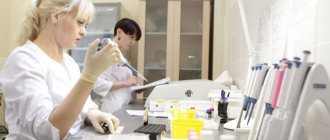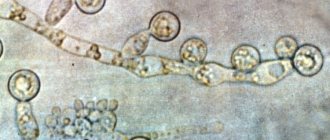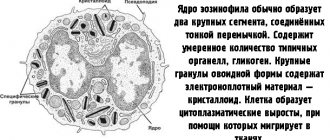Regular examination by a gynecologist is the responsibility of every woman who values her health. During a routine examination, the doctor usually takes a smear from the woman’s vagina for flora. Based on the results of laboratory tests, he can draw conclusions about the degree of purity of the vaginal microflora, and, if necessary, prescribe medications to normalize it. The doctor pays special attention to the amount of Dederlein bacilli present in a woman’s vagina, as this may indicate a problem.
What does a vaginal smear show?
A vaginal smear taken for analysis is applied to glass and then stained with specially designed dyes. Further examination of the material under a microscope is intended to determine the following indicators:
- slime;
- leukocytes;
- squamous epithelium;
- some pathogens;
- Dederlein sticks.
Vaginal cleanliness is measured by the ratio of the number of Dederlein rods to the number of cocci. With a reduced concentration of the former, the vaginal microbiocenosis is considered disturbed; in other words, this indicates the development of bacteriosis. This means that Dederlein's sticks are very important.
Warning signs
Unfavorable bacillary flora in a woman’s smear can only be revealed as a result of examination. But in some cases you can still suspect this. Several symptoms may indicate a gynecological disease.
- Itching and pain in the genital area, which intensify during sexual intercourse, may indicate vaginosis. But in some cases, these symptoms appear due to insufficient intimate hygiene. If in fact there is a disease, then other signs are added.
- A large amount of mucus with a sour odor is released from the vagina. It often resembles sour milk. The color of the mucus may be white or yellowish, but not transparent. Sometimes everything can be accompanied by minor pain in the lower abdomen.
All these signs together indicate that the woman has bacterial vaginosis (thrush). If treatment is not started on time, which is always quick and effective at the initial stage, then the discharge may acquire a curdled consistency and its quantity will increase. The smell will become more pungent and unpleasant and will be noticeable even to people nearby.
So, to accurately determine the rod in a smear, you must undergo tests. This is the only way to detect some dangerous diseases in time and begin treatment. After all, gynecological diseases often make themselves felt only when they are already in an advanced stage. Timely examination of flora on a stick is a good prevention of female diseases.
The special role of Dederlein sticks
These special bacteria are part of the vaginal microbiocenosis; moreover, they are its main part. Providing an acidic environment in the vagina is the main task performed by Dederlein sticks. What are they and how do they work? These are lactobacilli, that is, beneficial bacteria that, under a microscope, look like elongated rods (hence the name). The product of their vital activity is lactic acid. Why is it needed? In lactic acid, weak and poorly developed sperm die - this is how primary selection occurs.
The role of vaginal lactobacilli extends much wider. They promote the activity of macrophages, that is, immune cells that actively fight all harmful “outsiders.” In addition, Dederlein's bacilli provoke the production of biologically active substances and specific antibodies. And besides this, they are active participants in the processes involved in the work of local and general immunity.
What do Dederlein sticks say in a smear?
As already noted, these bacteria in the vaginal microbiocenosis quantitatively exceed all other components. If Dederlein bacilli are found in a very large quantity in the smear, then the woman is not infected with viruses, microbes or protozoa. If the analysis reveals that the number of lactobacilli has decreased, this will indicate the development of vaginal dysbiosis.
If the number of Dederlein rods in the vagina is reduced or they are completely absent, then the woman is either infected with something, or this is the result of internal changes in her body. The culprits of bacterial vaginosis and a series of other related diseases can be Trichomonas and Gardnerella. Also, the reasons for this extremely undesirable condition may be taking antibiotics, hormonal therapy, intestinal dysbiosis, disruptions in the production of hormones or the functioning of the immune system.
Usually, if a small number of Dederlein bacilli are detected in the general analysis, the gynecologist prescribes an additional analysis (bacterial culture) aimed at identifying the cause of such a deplorable state of the microflora.
Flora smear in women - the norm in the table with explanation
What does a smear on the flora in women show - the presence or absence of infectious diseases, inflammatory processes. This is a simple and quick way to study the microflora of the female reproductive system in the laboratory.
To whom and in what cases is a flora smear prescribed?
This is a laboratory study of the composition of the microflora of a woman’s genitourinary organs. A smear on the flora in women is considered to be the simplest way to determine sexually transmitted diseases.
In what cases is a woman prescribed a smear for flora:
- when an unpleasant odor appears;
- with pathological leucorrhoea, unusual discharge;
- for dryness and discomfort in the vagina;
- pain, bleeding after sexual intercourse;
- for pain, cutting during urination;
- before gynecological operations, colposcopy, IVF and any other gynecological manipulations.
A flora smear is prescribed to healthy women during a preventive examination with a gynecologist once or twice a year, when planning pregnancy, during pregnancy and upon admission to the maternity hospital.
How to prepare for the test
To get a reliable analysis result, you should prepare for it.
Preparation for the examination:
- stop taking antibiotics and antimycotic drugs two weeks before;
- within three days, all vaginal forms of medications are canceled;
- exclude any vaginal hygiene products (creams, deodorants, gels);
- for intimate hygiene, do not use any additional products other than water;
- sexual intercourse is excluded for 24 hours.
Before going for the test, wash thoroughly with warm boiled water, without additional hygiene products. It is not recommended to urinate before taking the test.
Time restrictions for taking the test: do not take it later than two days before the start of menstruation, and not earlier than two days after menstruation. The best period for taking a smear is from 10 to 20 days of the cycle.
How to get tested
For the convenience of collecting material, the woman is positioned in a gynecological chair. The gynecologist inserts a fixing speculum into the vagina.
What tools are used for analysis:
- from the vagina - with a sterile tampon;
- from the urethra - with a bacterial loop, cytobrush or Volkmann spoon;
- from the cervix - with an Eyre spatula.
A separate sterile instrument is taken for each area. The samples taken are placed on glass slides, labeled and sent to the laboratory.
The process of taking an analysis lasts several minutes and does not cause discomfort or pain (only superficial samples are taken, the mucous membrane is not injured).
How long to wait for results
The waiting time for test results depends on the workload of the medical organization. In a private laboratory, an analysis results form is issued within 24 hours or the next day after the material is submitted.
In the gynecological department at the local clinic, the analysis is done within 5 to 10 days.
Deciphering a smear for flora in women
The form with the analysis result contains letters, numbers, and “+++” signs.
Designation of the zone from which the material was taken:
- U (“uretra”) - urethra;
- C (“cervix”) - cervix;
- V (“vagina”) - vagina.
Designation of indicators that diagnose:
- L or Le - leukocytes;
- EP - epithelial cells;
- slime;
- Er - red blood cells;
- Gn or Neisseria gonorrhoeae - the causative agent of gonorrhea (gonococcus);
- Trich or Trichomonas SPP is the causative agent of trichomoniasis (Trichomonas);
- Soor or Candida, or Fungi, or Yeast - the causative agent of candidiasis;
- key cells;
- microflora.
The study of microflora is carried out by a laboratory assistant under a microscope. Abbreviated as “in p.z.” a laboratory employee notes that he noted these indicators only in visible space under a microscope.
What does the “+” symbol mean:
- one plus “+” means that a small amount of bacteria was detected;
- "++" means moderate amount;
- “+++” - high;
- "++++" - very high.
If infectious agents are not detected, they are marked as o or absolutely absent (indicated as “abs”).
Leukocytes
Leukocytes are white blood cells and their purpose is to fight infection. White blood cells are able to absorb bacteria and digest them. If there are a lot of leukocytes in the analysis, this means that the body is fighting the disease. A large number of leukocytes indicates a pronounced inflammatory process.
Epithelium
A high amount of epithelium indicates an inflammatory process. If a high concentration of epithelium is detected, additional examinations are prescribed.
If a proliferation of columnar epithelium is detected, the patient is referred for a colposcopic examination and oncocytology of the cervix to exclude precancerous diseases.
A reduced amount of epithelium indicates a hormonal deficiency. This picture is often observed in women of the climatic period.
Slime
If an increased amount of mucus is detected, an assumption is made about inflammation in the cervical canal.
Gram-positive rods
Gram-positive bacilli include lactobacilli and Doderlein bacilli. This is a component of healthy vaginal microflora. A decrease in the number of lactobacilli indicates vaginal dysbiosis, which is often associated with infectious diseases of the genital organs.
Key cells
Key cells are squamous epithelial cells that have separated from the mucosa, and small pathogenic microorganisms of gardnerella have accumulated on them. Normally, they are not detected in a smear.
Bacteria
The form indicates the types of bacteria found in the smear. The normal microflora of a healthy woman is rod-shaped (lactobacteria are rod-shaped).
The coccal form means that the smear is dominated by stalococci or streptococci.
The mixed form is observed in bacterial vaginosis, when many rod-shaped and coccal microorganisms are found.
The microflora of a healthy woman includes a whole range of microorganisms. Most of them are lactobacilli (Doderlein rods).
Composition of healthy female microflora:
Microorganisms Number of CFU/ml
| Lactobacilli, or Doderlein's bacillus Lactobacillus spp | 107-109 |
| Bifidobacterium Bifidobacterium spp. | 103-107 |
| Clostridia Clostridium spp. | Up to 104 |
| Propionibacterium spp. | Up to 104 |
| Mobiluncus Mobiluncus spp. | Up to 104 |
| Peptostreptococcus Peptostreptococcus spp | 103-104 |
| Corynebacterium spp. | 104-105 |
| Staphylococcus Staphylococcus spp. | 103-104 |
| Streptococci Streptococcus spp. | 104-105 |
| Enterobacteriaceae | 103-104 |
| Bacteroides spp. | 103-104 |
| Prevotella spp. | Up to 104 |
| Porphyromonas Porphyromonas spp. | Up to 103 |
| Fusobacterium Fusobacterium spp. | Up to 103 |
| Veilonella spp. | Up to 103 |
| Mycoplasma M.hominis | Up to 103 |
| Ureaplasma U.urealyticum | 103 |
| Candida - yeast-like fungi | 104 |
Normal flora smear values
The results of the analysis are entered into the form-table. Different laboratories have developed their own forms, but they all include the same set of indicators with the same designation.
A table with a breakdown of the norms in a smear in women.
Indicator Vagina (V) Cervical canal (C) Urethra (U)
| Leukocytes(L or Le) | 0-10 | 0-30 | 0-5 |
| Epithelium (Ep) | 5-10 | 5-10 | 5-10 |
| Slime | Moderately | Moderately | – |
| Gonococci (Gn) | No | No | No |
| Trichomonas (Trich) | No | No | No |
| Key cells | No | No | No |
| Candida, yeast (Soor or Candida) | No | No | No |
Degree of vaginal cleanliness
A smear on the flora determines the degree of vaginal cleanliness. There are 4 degrees of purity:
- 1st degree (ideal option) - leukocytes are normal, flora is healthy, mucus and epithelial cells are present in small quantities;
- 2nd degree (a common variant of the norm, on the verge of microflora disturbance) - leukocytes within normal limits, mucus and epithelial cells in moderate quantities. There are a small number of cocci or fungi, lactobacilli - in large quantities;
- Grade 3 (deviation from the norm, indicates the onset of the disease) - a lot of leukocytes and epithelium. There are few beneficial lactobacilli, there is active growth of Candida fungi and pathogenic microbes;
- Grade 4 (indicates a disease) - a lot of leukocytes, pathogenic bacteria. Doderlein bacilli are absent (lactobacillus). Lots of mucus and epithelium.
Table of indicators of the degree of vaginal cleanliness.
Degree of purity Leukocytes Epithelium Mucus Microflora Description
| 1 | Single | 5-10 in point of view | Moderate amount | pH - sour, Doderlein sticks - no less than 95% | Ideal state of microflora |
| 2 | Up to 10 in p.z. | 5-10 in point of view | Moderate amount | pH - acidic, presence of a small number of gram-positive cocci, Doderlein rods predominate | Normal state of microflora |
| 3 | 10-30 in p.z. | More than 10 in p.z. | Moderate to large amounts | pH - neutral or slightly alkaline, presence of gram-negative and gram-positive cocci, Doderlein bacilli in small quantities or absent | Inflammatory process in the vagina, treatment required |
| 4 | More than 30 in p.z. | Completely | A large number of | pH - alkaline, a large number of opportunistic and pathogenic bacteria, no Doderlein bacilli | Severe inflammatory process requiring immediate treatment |
Flora smear for pregnant women
A smear for flora is taken when planning a pregnancy, to prepare for conception (to take care of your health in advance). At the antenatal clinic, the expectant mother undergoes a smear test for flora for preventive purposes three times:
- upon registration;
- at the beginning of the 2nd trimester;
- at the beginning of the 3rd trimester;
- at 37-38 weeks of pregnancy, before birth.
A flora smear for pregnant women is a method of preventing intrauterine infection of the baby. If an infection is detected, doctors offer optimal treatment regimens.
During pregnancy, the norm in a smear for flora in women corresponds to the norm for non-pregnant women with one difference: the number of leukocytes in the vagina is allowed up to 20 and higher numbers of epithelium and Doderlein rods are considered normal.
These differences are due to the fact that nature has designed to increase the protective reactions of the expectant mother’s body (for the successful bearing of a baby).
Analysis validity period
The results of a smear test for flora are valid for 10 days. Gynecologists recommend that patients undergo a flora test once to twice a year as a preventative measure. The analysis provides information about the possible development of the disease even when the woman feels quite well. Early treatment produces results faster and better than treatment of advanced diseases.
0
0
21613
Source: //littleone.com/publication/0-6715-mazok-na-floru-u-zhenshchin-tablica-s-normami
How to increase the number of Dederlein sticks
The number of lactobacilli in the vagina can be brought back to normal only after the reasons for the reduction in their numbers have been identified and eliminated. Bakposev (analysis when a smear from the vagina is placed in an artificial nutrient medium) helps not only to identify harmful bacteria and fungi, as well as their quantity, but also to conduct experiments to determine antibiotics suitable for treatment.
After properly carried out sanitation of the vagina, restorative therapy is usually prescribed to normalize the microflora. At this time, it is advisable to use vaginal suppositories, with the help of which beneficial bacteria, including Dederlein bacilli, are colonized.
Dederlein's bacilli play a major role in protecting the female genital tract from infection and affect the immunity of the entire body. A decrease in their number indicates the development of vaginal dysbiosis, which may be due to various reasons. Only after their elimination can the vaginal microbiocenosis be restored. If this condition is ignored, the most unpleasant and dangerous diseases can develop over time.
Useful and harmful sticks
Deciphering the tests helps to identify which useful and harmful rods live in a woman’s reproductive system.
If necessary, different tests can be done to determine each specific type of rod. But there are a few sticks that should be detected anyway.
Small rod flora in a woman’s vagina is considered dangerous. It indicates that the smear may contain gram-negative harmful bacteria, which greatly reduce immunity and prevent the body from fighting even the most minor diseases.
If small rod flora is abundant, this is an alarming signal. The doctor must definitely prescribe complex treatment with special drugs that can restore normal microflora in the vagina. Small rod flora may also indicate the presence of diseases such as gardnerellosis or dysbacteriosis. Then the treatment must follow a strict regimen, which is developed by the attending physician.
The greatest danger is that the flora mixed with a predominance of small rods can, over time, destroy the beneficial flora of the vagina. And then it will be quite difficult to avoid complications that can even lead to infertility.











